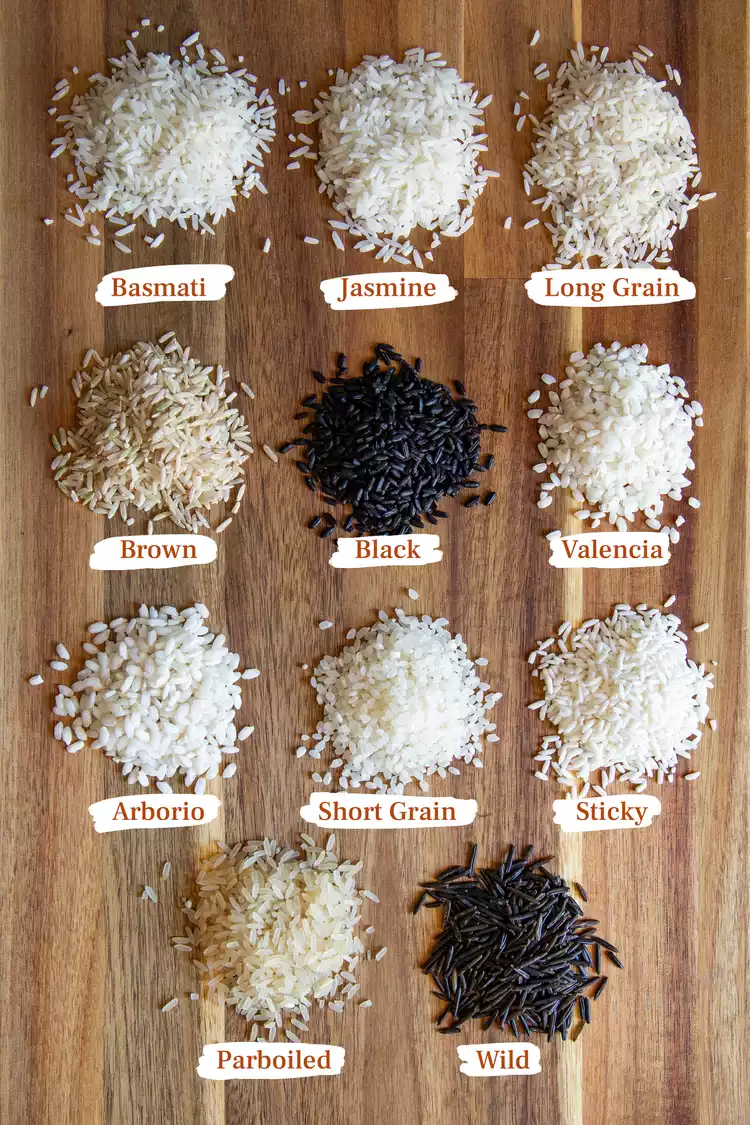| Rice Types |
Processing Method |
Characteristics |
Common Uses |
Comparison |
Region |
Nutrition Information (per 100g) |
Key Nutrition |
| Raw Rice |
Rice grains are milled directly after harvesting without soaking or boiling. |
White, polished grains, soft texture after cooking, shorter shelf life. |
Used in everyday meals, idli, dosa, pulao, and biryani. |
Quick to cook, retains most flavor, but loses some nutrients during milling. |
Widely available |
Calories: 130 kcal; Fat: 0.3 g; Carbohydrates: 28 g; Fiber: 0.4 g; Protein: 2.7 g |
High in carbohydrates; Low in fiber and fat; Moderate protein content |
| Boiled Rice |
Rice is fully boiled after harvesting, before or after milling. |
Firmer texture, can take longer to cook, less sticky, retains more nutrients. |
Common in South India, also used in Bengal and Assam for meals like rice and curry. |
Healthier due to nutrient retention, firmer than raw rice, takes longer to cook. |
Bengal, Assam, North East India, Bangladesh |
Calories: 130 kcal; Fat: 0.3 g; Carbohydrates: 28 g; Fiber: 0.4 g; Protein: 2.7 g |
High in carbohydrates; Low fat and fiber; Moderate protein level |
| Steamed Rice |
Steamed during processing and then dried. |
Retains its natural flavor, is fluffy and less sticky when cooked. |
Used in everyday meals, also used in Bengal for dishes like Bhog (offering). |
Similar to raw rice but lighter and fluffier. Retains more nutrients than raw rice. |
Bengal, Assam, North East India, Bangladesh |
Calories: 130 kcal; Fat: 0.3 g; Carbohydrates: 28 g; Fiber: 0.4 g; Protein: 2.7 g |
Carbohydrate-rich; Low in fat and fiber; Soft texture when cooked |
| Parboiled Rice |
Partially boiled with the husk on, then dried, milled, and polished. |
Golden color before cooking, slightly firmer and fluffier, less sticky. |
Common in South India and Bengal for meals, used in dishes like pongal and khichuri (Bengal). |
More nutrient-rich than raw rice, faster cooking than boiled rice, retains some firmness. |
Bengal, Assam, North East India, Bangladesh |
Calories: 125 kcal; Fat: 0.32 g; Carbohydrates: 26.45 g; Fiber: 0.65 g; Protein: 3.23 g |
Retains more vitamins and minerals; Moderate protein content; Less sticky than raw rice |
| Brown Rice |
Only the outer husk is removed, leaving the bran and germ intact. |
Light brown color, chewy texture, nutty flavor, longer cooking time. |
Used in health-conscious meals, salads, and stir-fries. |
Most nutritious type of rice, high in fiber and minerals, but takes longer to cook. |
Widely available |
Calories: 112 kcal; Fat: 0.9 g; Carbohydrates: 23 g; Fiber: 1.8 g; Protein: 2.3 g |
High in fiber; Rich in minerals like magnesium; Lower calorie content compared to white rice |
| Basmati Rice |
Long-grain aromatic rice with a distinct aroma and flavor. |
Elongates significantly when cooked, fluffy and separate grains. |
Used in Indian and Middle Eastern cuisine, especially for biryani and pulao. |
Aromatic and flavorful, fluffy texture, but can be more expensive. |
India, Pakistan |
Calories: 130 kcal; Fat: 0.2 g; Carbohydrates: 28 g; Fiber: 0.5 g; Protein: 2.8 g |
High in carbohydrates; Low fat content; Light and aromatic, suitable for special dishes |
| Aromatic Short-Grain Rice |
Milled, often polished, with husk and bran removed. |
Short, aromatic, sticky texture after cooking. |
Used in festive dishes like payesh, khichuri, and special offerings. |
Short-grain and fragrant, used in traditional cooking, softer texture. |
Bengal, Assam, and some parts of India. |
Calories: 130 kcal; Fat: 0.2 g; Carbohydrates: 28 g; Fiber: 0.5 g; Protein: 2.8 g |
High in carbohydrates; Low in fat; Soft and sticky when cooked. |
| Sticky Rice (Bora Rice) |
Short-grain rice, glutinous, and unpolished. |
Sticky texture when cooked, glutinous. |
Used in desserts like pitha, sweet rice dishes, and payas. |
Very sticky compared to other rice, higher in starch. |
Assam, North-East India. |
Calories: 97 kcal; Fat: 0.1 g; Carbohydrates: 21 g; Fiber: 0.5 g; Protein: 2 g |
Higher starch content; Lower calories; Sticky texture when cooked. |
| Wild Rice |
Technically a seed from a different plant, not rice. Minimally processed, outer husk removed, often roasted. |
Chewy texture, nutty flavor, dark brown or black color. |
Used in salads, soups, and side dishes. |
Higher protein and fiber compared to white rice; unique texture. |
North America, also grown in India. |
Calories: 101 kcal; Fat: 0.3 g; Carbohydrates: 21 g; Fiber: 1.8 g; Protein: 4 g |
Higher in protein; Rich in fiber; Nutty flavor. |
| Jasmine Rice |
Polished white rice, sometimes brown with husk and bran intact. |
Long-grain, soft, and aromatic when cooked. |
Used in Asian cuisines, typically served with curries and stir-fries. |
Similar to Basmati but slightly more sticky when cooked. |
Thailand, Southeast Asia. |
Calories: 130 kcal; Fat: 0.3 g; Carbohydrates: 28 g; Fiber: 0.5 g; Protein: 2.9 g |
Rich in carbohydrates; Soft texture; Slightly fragrant. |
| Arborio Rice |
Short-grain rice, often milled and polished. |
Short, starchy, creamy texture when cooked. |
Used primarily in risotto and rice pudding. |
Higher starch content compared to other rice types; creamy when cooked. |
Italy, also grown in other parts of the world. |
Calories: 130 kcal; Fat: 0.3 g; Carbohydrates: 29 g; Fiber: 0.4 g; Protein: 2.4 g |
Rich in starch; Provides a creamy texture when cooked; Low in fiber. |
| Red Rice |
Retains some of the bran layer, giving it a reddish color. |
Slightly chewy texture, nutty flavor, high in antioxidants. |
Used in salads, pilafs, and South Indian cuisine. |
Healthier than white rice, high in fiber and antioxidants, but less common. |
South India, Bhutan, Nepal |
Calories: 110 kcal; Fat: 0.8 g; Carbohydrates: 23.5 g; Fiber: 2.8 g; Protein: 2.5 g |
High fiber content; Rich in iron and antioxidants; Good source of protein |
| Black Rice |
Unmilled rice with a deep purple-black hue, high in antioxidants and fiber. Also known as forbidden rice, has a black husk and a deep purple color when cooked. |
Chewy texture, nutty flavor, rich in antioxidants. |
Used in health-conscious meals, desserts, and special dishes in North-East India |
Rare, nutrient-rich rice, requires longer cooking, becoming popular due to health benefits. |
Common in North-Eastern India, especially Manipur. |
Calories: 180 kcal; Fat: 1.9 g; Carbohydrates: 34 g; Fiber: 2.3 g; Protein: 6.5 g |
High in antioxidants (anthocyanins); Good source of protein; High fiber content |



